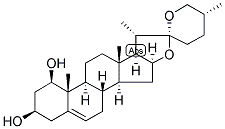商品中心
联系我们
长沙捷凯生物制品有限公司
联系电话:
+86-0731-82287663
+86-0731-82284663
传真号码:
+86-0731-82284663
邮 编:410016
地址:湖南省长沙市万家丽中路一段166号东郡华城广场A座2505室
商品名称:
Butcher’s Broom Extract

规格:
10%, 20% Ruscogenins HPLC
拉丁名:
Ruscus aculeatus Linn.
使用部位:
Roots
检测方法:
HPLC
CAS编号:
472-11-7
主要功能:
Circulation and Cardiovascular Support, Anti-inflammatory
所属分类:
热销产品
关键词:
植物提取物
商品详情
Brief Introduction
Synonyms--- Kneeholy, Knee Holly, Kneeholm, Jew’s Myrtle, Sweet Broom, Pettigree
Ruscogenin (Ruscogenin, Ruscogenine, Ruscogenin(P), Ruscorectal)
Chemical Name: (1B,3B,25R)-SPIROST-5-ENE-1,3-DIOL, (25R)-spirost-5-ene-1-beta,3-beta-diol, Spirost-5-ene-1,3-diol, (1.beta.,3.beta.,25R)-
Molecular Formula: C27H42O4
Mol. Wt.: 430.62

Butcher's broom, Ruscus aculeatus, is a low evergreen Eurasian shrub of the lily family (Liliaceae), with flat shoots known as cladodes that give the appearance of stiff, spine-tipped leaves. Small greenish flowers appear in spring, and are borne singly in the centre of the cladodes. The female flowers are followed by a red berry, and the seeds are bird-distributed, but the plant also spreads vegetatively by means of rhizomes. Ruscus aculeatus is very hardy, thriving in almost any soil or situation, its root is thick, striking deep into the ground. When dry, it is brownish grey, 2 to 4 inches long and 1/3 inch in diameter, having somewhat crowded rings and rounded stem scars on the upper surface and many woody rootlets below. If a transverse section be made, a number of vascular bundles in the central portion are to be seen. It is often planted in shrubberies or edges of woods, on account of its remaining green after the deciduous trees have shed their leaves. It is also widely planted in gardens, and has spread as a garden escape in many areas outside its native range. The matured branches used to be bound into bundles and sold to butchers for sweeping their blocks, hence the name: Butcher's Broom. It is frequently made into besoms in
The young shoots of Butcher's Broom in Spring have often been eaten like those of the Asparagus, a plant to which it is closely allied. The roots or rhizomes for medicinal uses are collected and prepared in autumn. The root has no odor, but its taste is sweetish at first and then slightly acrid.
The plant has a long history of use. More than 2000 years ago, it was noted as a laxative, diuretic, and a phlebotherapeutic (beneficial to veins) agent. Extracts, decoctions, and poultices have been used throughout the ages, but the medicinal use of this plant did not become common until the last century. Early investigations during the 1950s indicated that extracts of butcher's broom could induce vasoconstriction and therefore might have use in the treatment of circulatory diseases. The increasing popularity of natural and herbal remedies in
The Butcher’s Broom Extract used in dietary supplements is derived from the roots of Ruscus aculeatus Linn.
• Improve chronic venous insufficiency
• Treat Varicose veins
• Prevent Atherosclerosis
• Vasoconstriction (blood vessel narrowing) effects
• Tone up a sluggish venous system and reduces capillary fragility
• Treat venous circulatory disorders (especially for women complaining of a heavy sensation in the legs, and leg cramps, itching and swelling)
• Enzymatic effect reduces pain and swelling
• Treat hemorrhoids
• Anti-inflammatory
The primary contituents of butcher's broom include steroidal saponins such as Ruscogenin and Neo-ruscoginin (totally called Ruscogenins), which are believed to be responsible for the herbs medicinal effects. Ruscogenin is the aglycone of ruscin, and Neo-ruscogenin is another steroidal saponin. The two aglycones are more similar to each other than are isomers (which are identical except for rotation). Neo-ruscogenin simply has one more double bond than ruscogenin. Neo-ruscogenin is also biologically active, and its presence in the guaranteed potency herb preparation is counted with ruscogenin. This is done, even though the two aglycones occur in variable amounts of each, depending on the region where the butcher's broom rhizomes were gathered, because the two chemicals are almost identical, both in chemistry and in activity.
The active components of butcher's broom are ruscogenins. In guaranteed potency form, these saponins should be present in a 10% concentration. Whole butcher's broom should be used, since isolated ruscogenins may not possess the same activity or lack of toxicity as whole plant materials
Standard dosage as food or medicine has no side effects, even at high doses. Concomitant toxicological screenings suggested the herb was extremely safe to use, much more than other preparations being used to treat hemorrhoids. Based on the low toxicity findings, several pharmaceutical houses quickly prepared creams, salves and ointments for testing as external applications to hemorrhoids in human patients. The results were highly significant.
Nausea and queasiness may result in rare cases.
Neoruscogenin and ruscognin phytosterols that decrease vascular permeability and anti-inflammatory effect may cause small veins to restrict to increases perspiration.
Because of venous constriction avoid if you have high blood pressure, or are on blood pressure reducing drugs.
Any steroidal-like compound should be carefully considered if you have a history of cancer in your family.
Consult your holistic health care physician.
This herb has approval status by the German Commission E.
Pregnancy/nursing:Information regarding safety and efficacy in pregnancy and lactation (nursing ) is lacking. Avoid use.
Interactions: The antiinflammatory activity of butcher's broom can be seriously inhibited by phenobarbital and certain other sedatives and hypnotics (chloral hydrate, meprobamate, etc.), as well as a beta-adrenergic blocking agents (propranolol).
Colchicine may increase sensitivity or enhance the response to butcher's broom.
The sympathomimetic action of the uterine relaxant Ritodrine Hydrochloride and the vasocontricting property of butcher's broom are additive.
Toxicities: Not known to be toxic.
• The typical dose is 100mg-1000mg per day (usually in 2-3 doses throughout the day).
• Consult physicians for different condition specifics.
GNI’s Butcher’s Broom Extract Features and Benefits:
Butcher’s Broom Extract is one of GNI's main products, with many advantages as list in the following, produced as our patent-pending process and know-how technology from Ruscus aculeatus Linn. roots
• Produced with pure water only
• High purity: over 20%
• NO solvent - residual free
• Pesticide-free
• Natural Brown-Yellow in appearance
• High solubility in water
• High anti-bacteria, and longer shelf life
推荐商品

